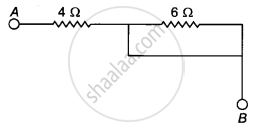Advertisements
Advertisements
प्रश्न
How will the resistance of a wire be affected if its
- length is doubled, and
- radius is also doubled ?
Give justification for your answer.
उत्तर
R `=(rho"l")/"A"`
Where, `rho` = electrical resistivity
l = length of the conductor
A = cross-sectional area of the conductor
Hence if the length is double then
⇒ `"R"_1=rho((2"l"))/"A"`
`therefore "R"_1 = 2("R")`
So, if the length of the resistance gets doubled then resistance also gets doubled.
Now when the radius is double then
⇒ `"R"_2 = (rho"l")/"A"`
⇒`"R"_2 = (rhol)/(pi(2"r")^2`
`therefore "R"_2 = 1/4("R")`
So if the radius gets doubled then resistance will be `(1/4)^"th"` of initial resistance.
APPEARS IN
संबंधित प्रश्न
Which of the following are conductors and which are insulators?
Sulphur, Silver, Copper, Cotton, Aluminium, Air, Nichrome, Graphite, Paper, porcelain, Mercury, Mica, Bakelite, Polythene, Manganin.
Which has less electrical resistance : a thin wire or a thick wire (of the same length and same material)?
Distinguish between good conductors, resistors and insulators. Name two good conductors, two resistance and two insulators.
What happens to the resistance as the conductor is made thicker?
Which has more resistance:
a long piece of nichrome wire or a short one?
Give two examples of substances which are good conductors of electricity. Why do you think they are good conductors of electricity?
What would be the effect on the resistance of a metal wire of:
increasing its length?
Resistance of a metal wire of length 5 m is 100 Ω . If the area of cross - section of the wire is `3 × 10^-7 "m"^2` , Calculate the resistivity of the metal .
How will you infer with the help of an experiment that the same current flows through every part of the circuit containing three resistors R1, R2 and R3 in series connected to a battery of V volts?
The effective resistance between A and B is:

